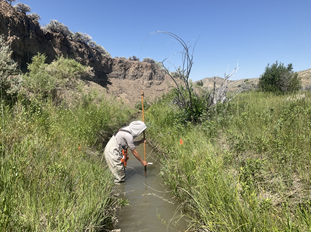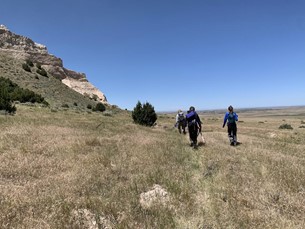Hello! My name is Alaine Quinn, and I’m a conservation biology major going into my fourth and final year at Colorado State University. Ever since I was little, I knew my dream job had something to do with wildlife and being outdoors. Working with the Colorado Natural Heritage Program this summer was a dream come true. Through this internship, I was able to gain valuable field experience and work with so many cool scientists and individuals. I was also able to become more confident as an emerging conservation biologist, and I loved being a part of such an amazing team who collects important data used to protect our natural resources.
One of my favorite things about this internship was the different projects I was able to work on. The two projects I spent the most time on were the BLM lotic and lentic AIM (Assessment Inventory Monitoring) projects. For the AIM projects, I spent six to seven days out in Wyoming working with a crew to collect field data. Both lotic and lentic projects each had a strict protocol that we followed at every one of the sites. The lentic sites we went to were classified as wetland areas. During this time I got experience in collecting water quality data from still water bodies and groundwater, collecting vegetation data using the LPI (Line Point Intercept) method, digging soil pits, taking soil data, measuring hummocks, collecting data on woody plants, and more. The lotic sites we went to were classified as riparian areas and had moving water. During this time I got experience in collecting vegetation data using the MIM (Multiple Indicator Monitoring) method, using a surber sample to collect macroinvertebrates, collecting data on stream bed particles, measuring bankfull width and wetted width, measuring bankfull height, doing bank assessments, and more. I was able to practice my off-roading driving skills too because it was needed to get to most of our sites. Between the two lotic and lentic projects I had also become an expert camper and learned what I needed to pack to live in the wilderness for six to seven days.


For the last couple weeks of the internship, I was able to work on a couple of other projects. One of them was a BioBlitz where a bunch of different scientists and volunteers came together to find as many species of everything in a given area. My favorite part about the BioBlitz was being surrounded by so many scientists and people who specialized in different things. During this time I was able to go out with a zoologist, birders, moss experts, and botanists. It was also a nice break from following a super strict protocol because with the BioBlitz you could just wander around anywhere in the area. On the last day, we had an education day that was open to the public. It was super cool to see so many people come together to see the results of our findings. I also thought it was super neat to be around so many people who share the same passions as me.

One of the last projects I took part in was building beaver dams. This was different from the other projects I was previously doing because it was less focused on data collection and more focused on restoration. To build the beaver dams we had to wear PPE (personal protective equipment) because we were working with power tools and moving big branches into the stream. The coolest part about this project was seeing how fast we were able to get results. After only working for an hour we already saw the water level becoming higher.
What I loved the most about all of these projects were the people I was able to interact with and learn from. I will forever cherish the relationships I was able to build this summer, and I’m grateful for all the memories I made with them. This was truly a dream internship, and I loved how I got a flavor of all the meaningful work CNHP does. Because of this internship I grew so much as a person and as a conservation biologist. I now feel more confident in the field, and I have a better understanding of where I want to take my career path. Thank you CNHP for everything you have done for me and everything you do for our beautiful ecosystems here in Colorado!




